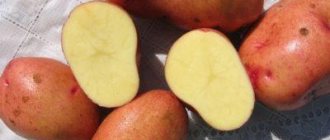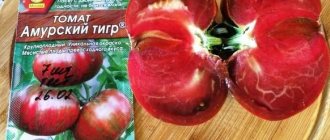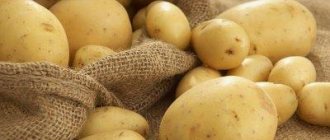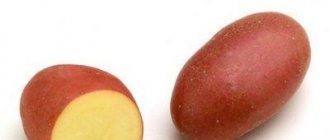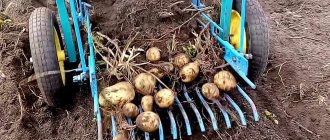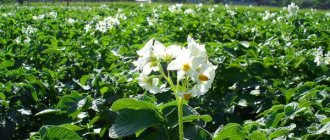League potato variety characteristics
General characteristics: early-ripening, Russian potato variety with elongated oval tubers.
Adapts to soil and climate. Easy to care for. Maturation period (vegetation): 70-75 days (the first digging is possible on the 45th day after emergence).
Starch content: 11.8-16.4%.
Weight of commercial tubers (grams): 92-125 grams.
Number of tubers in a bush: 6-10 pieces.
Productivity (c/ha): 211-354.
Consumer qualities: good taste, average cooking ability, suitable for making soups, salads, boiling in jackets, chips and French fries.
Keeping quality (storage ability): 93%.
Peel color: yellow.
Flesh color: light yellow.
Preferred growing regions (RF): Western, Northwestern.
Disease resistance: the variety is resistant to potato canker and golden cyst nematode, and is moderately susceptible to late blight on tops and tubers.
Features of cultivation: germination of tubers is recommended, sowing pattern - 60x35 cm, depth - 8-10 cm, standard agricultural technology.
Other: the originator of the Liga potato variety is Selectionnaya LLC (Russia).
Diseases and parasites
The Liga potato variety is resistant to golden nematode and cancer. The subspecies is moderately susceptible to late blight of shoots and tubers. Preventive treatment is carried out with insecticides against the Colorado potato beetle, aphids, and wireworms.
Blackleg
A common disease. The pathogen is perfectly adapted to different characteristics of weather conditions. Reducing the acidity of the soil helps reduce the likelihood of disease. It is not advisable to plant tomatoes, cabbage or radishes next to potatoes.
Infection occurs at different stages of the growing season. Dry weather contributes to the pathogen attacking potato plants.
Characteristics of disease symptoms of the Liga variety:
- the stem at the base turns black and rots;
- plant growth stops;
- the edge of the leaf blade curls;
- the tops become covered with brown spots.
The soil around the infected plants is loosened and dusted with wood ash. Diseased bushes are removed. The soil is sprayed with a solution of copper sulfate.
Macrosporiasis
The pathogen multiplies at +18 - +22°C. Spreads with heavy dew or rain. From the moment of infection to the appearance of the first signs of the disease on the plant, it takes from 3-4 to 14 days.
Characteristics of symptoms of damage to the Liga variety:
- round yellow spots up to 1.5 cm in diameter appear on the leaf blade;
- the affected area darkens;
- gray-brown pubescence forms on the underside of the leaf;
- the stem becomes covered with brown spots;
- plant tissues die.
To prevent infection, seed material is carefully selected before planting. Tubers are treated with a solution of potassium permanganate. Potato tops are sprayed with garlic infusion every 1.5-2 weeks. Compliance with crop rotation on the site prevents the accumulation of pathogens in the soil.
Aphid
Small pests up to 2-3 mm in length. They feed on plant sap and live in colonies. A cluster of insects occupies the underside of the leaf blade.
Characteristics of signs of aphid damage to potatoes of the Liga variety:
- the lower leaves curl and dry out;
- the tops wither;
- clusters of ants are noticeable on the stems;
- bushes are affected by sooty fungi.
To attract natural aphid fighters, umbrella plants are planted on the site. Ladybugs, hoverfly larvae and lacewings will help in the fight against the parasite.
Potatoes "League" - the pride of domestic selection
Potatoes "League" were obtained through selection and deservedly belong to the best early-ripening, high-yielding varieties suitable for cultivation in our country. The variety is included in the State Register of Russia, recommended for cultivation on private plots in the North-West region and zoned in 2007.
Description of the variety
The bushes are low or medium height, intermediate type, semi-erect. The corollas on the flowers are colored red-violet. Leaves can be either medium or large in size. The root crops are elongated-oval in shape, covered with a smooth, yellow skin and have fairly small eyes. The average weight of the root vegetable is 114 g. The pulp is light yellow, with a starch content of no more than 16.4%, very tasty. Maximum yield 43.1 t/ha.
Potatoes called "League" have sufficient resistance to the causative agent of potato cancer and the golden potato cyst nematode. In accordance with the data of the All-Russian Research Institute of Phytopathology and according to the description of the variety by the originator, the plant compares favorably with most varieties in its moderate susceptibility to the causative agent of late blight, which has been very widespread in recent years, and therefore the use of modern very strong chemicals is not required to prevent this dangerous potato disease.
Planting potatoes
Potatoes "League" are among the few varieties that are not very demanding on the composition of the soil in the planting area. To grow this variety, you can use any traditional methods of planting potatoes. As a rule, potatoes are planted in a row according to a 25x80 cm or 30x80 cm pattern. However, the tops of the Liga potato variety are not too thick, and prepared tubers can be planted even thicker.
In areas where groundwater is located above 0.5-0.7 m or where excess moisture accumulates in the soil, it is advisable to plant potatoes on ridges prepared in advance. In all other cases, planting material is most often planted in furrows, with simultaneous plowing of mineral and organic fertilizers.
The optimal site for planting potato tubers of early varieties is a quickly drying place on a personal plot, which was not used for growing potatoes in the previous year. The planting depth of prepared potato tubers should be about 6-8 cm, with the expectation of subsequent planting of the vegetable crop during the care process.
Also read: Shallots: choosing a variety and growing rules
How to plant potatoes (video)
Features of care
Potatoes "League" belong to the early category and are planted in May. Quite often, early varieties are subject to freezing as a result of the return of late spring frosts. Caring for early potatoes of the “League” variety should begin approximately ten days after planting the sprouted tubers.
Article on the topic: Potato variety “Karlena” - description and photo
If potato seedlings have already appeared and there is a possibility of damage by return frosts, the planting should be covered with garden plastic film or watered abundantly and the method of smoking or hilling the plants with tops should be used.
The standard set of measures for caring for early potato plantings consists of timely and regular destruction of weeds, removal of soil crust, as well as the creation of the most favorable temperature and humidity conditions necessary for the full growth and development of potatoes.
Good results and a high yield of high-quality tubers are ensured by three times of watering during the growing season. It is important to supplement such irrigation measures with the introduction of high-quality fertilizers. For fertilizing, it is advisable to use both organic and mineral complexes, the application of which is recommended to be alternated.
A very important measure when caring for potatoes is still the timely protection of potato plantings from the Colorado potato beetle.
If agricultural techniques are followed, it is possible to obtain crumbly and tasty new potatoes in the early stages.
Reviews from vegetable growers
Experienced potato growers advise planting Liga potatoes when grown on personal plots in the traditional row method according to the 60x30 cm pattern, and in the presence of highly fertile soil and fine planting material, thickening them in rows up to 0.25 m.
Also read: Lukhovitsky cucumbers: the secret of popularity
Reviews about the yield obtained with this method of cultivation are positive. The tubers are large, marketable and have a good shelf life. However, the best option still remains the cultivation of early varieties of potatoes, zoned in a specific area.
Potatoes: planting methods (video)
Attention, TODAY only!
Did you find an error in the text? Please select it and press Ctrl+Enter. Thank you!
(3 ratings, average: 4.83 out of 5) Loading.
Characteristics, description, yield, reviews and photos of the “League” potato variety.
Yellow potato varieties are considered very tasty. “League” among them is also a universal species, because it is not only consumed as food, but also produces various components, for example, starch.
Potatoes of various varieties:
An early-ripening potato variety was bred by breeding and entered into the State Register of the Russian Federation.
It was recommended to be grown on private farms in the North-West region.
This high-yielding type of potato has a short ripening period - only 70-75 days. The starch content in root vegetables is 12-16%.
From one hectare you can get 210 - 350 c. The weight of ripened tubers is 90 - 125 g.
The shape of the root crops themselves is oval-elongated. Potatoes have a dense, smooth yellow skin. The pulp is dense, watery, light yellow in color.
The bush itself is spreading, semi-erect, the greenery is medium undulating. Blooms with pale purple or dark red inflorescences.
Advantages and disadvantages. Taste qualities
Among the clear “advantages” of this potato are:
- Early ripening;
- High yield;
- Good keeping quality;
- Excellent taste;
- Versatility of use;
- Immunity to many diseases;
- Resistance to mechanical damage;
- Large fruits with superficial eyes;
- Tolerates drought well.
FOR REFERENCE: Potatoes improve their quality if the soil is fertilized with substances that contain potassium.
But there are also some “disadvantages”:
- Susceptible to tuber blight;
- Has some isolated low-quality signs.
Potatoes collected for planting usually sprout vigorously; long shoots should be removed immediately. Planting material should be prepared 1 - 2 weeks in advance.
The tubers need to be sorted out, the good ones separated from the bad ones, and placed in a sunny place so that they turn slightly green.
ATTENTION: Some gardeners advise planting green potatoes because they develop better further. But there is no need to eat root vegetables of this color - harmful substances accumulate in it.
For planting, choose an area that dries quickly. It is important that potatoes were not planted on it the previous year.
"League" is not demanding on the composition of the soil. They plant it in the traditional way in a row, using a 25x80 cm pattern. They deepen it into the ground no more than 8-10 cm.
Since planting of the “League” begins already in May, it is possible that the potatoes may be damaged by reverse frosts in the event of a sudden cold snap. To prevent this from happening, 10 days after planting the sprouted tubers, the sprouted tops are covered with film.
Selecting potato varieties:
In general, the set of care measures will be standard:
- Weed removal.
- Getting rid of soil crust.
- Hilling.
- Getting rid of the Colorado potato beetle.
During the growth period of the “League”, you can water it three times. It’s good if it is combined with fertilizing. Fertilizers are applied both organic and mineral. It is advisable to alternate them with each other.
Article on the topic: Potato variety “Irbitsky” - description and photo
Diseases and pests
“League” is resistant to many diseases, but it is still not immune from late blight of tops and tubers. It can also be attacked by the Colorado potato beetle and wireworm. To protect the plant, it is sprayed with special preparations for preventive purposes.
Early potatoes are harvested immediately after they are technically ripe.
Vegetable growers note that by following simple conditions for growing potatoes, you can get large, even, beautiful tubers that have a rich, pleasant taste and can be preserved for a long time.
The most productive potato varieties:
We recommend articles on the topic
Description of the potato variety League
Characteristics of the Liga potato variety.
Originator: Selectionnaya LLC.
The potato variety is early ripening and suitable for the production of chips. The taste is good.
The plant is low to medium height, intermediate type, semi-erect. The leaf is medium to large, intermediate in size, dark green. The edge undulation is strong. The corolla is red-violet.
The tuber is elongated-oval with small eyes. The peel is smooth, yellow. The pulp is light yellow. The weight of the commercial tuber is 92-125 g. The starch content is 11.8-16.4%.
The variety is resistant to the pathogen of potato cancer and golden potato cyst nematode. According to the All-Russian Research Institute of Phytopathology, the tops and tubers are moderately susceptible to the causative agent of late blight.
The marketable yield of the Liga potato variety is 211-354 c/ha, at the level and 76 c/ha higher than the Pushkinets standard. Productivity on the 45th day after full germination (first dig) 98-175 c/ha, at the level and 36 c/ha above the standard, on the 55th day (second dig) 115-242 c/ha, at the level and 82 c/ha above the standard. The maximum yield is 431 c/ha, at the level of the Latona standard (Vologda region). Marketability 83-94%. Keeping quality 93%.
The potato variety is included in the State Register for the North-West region.
Description of the variety
The bushes are low or medium height, intermediate type, semi-erect. The corollas on the flowers are colored red-violet. Leaves can be either medium or large in size. The root crops are elongated-oval in shape, covered with a smooth, yellow skin and have fairly small eyes. The average weight of the root vegetable is 114 g. The pulp is light yellow, with a starch content of no more than 16.4%, very tasty. Maximum yield 43.1 t/ha.
Potatoes called "League" have sufficient resistance to the causative agent of potato cancer and the golden potato cyst nematode. In accordance with the data of the All-Russian Research Institute of Phytopathology and according to the description of the variety by the originator, the plant compares favorably with most varieties in its moderate susceptibility to the causative agent of late blight, which has been very widespread in recent years, and therefore the use of modern very strong chemicals is not required to prevent this dangerous potato disease.
Video about the “League” variety
Unfortunately, there is no video for this variety at the moment. We invite you to watch the video section of our website, where other videos about potatoes and other agricultural crops are posted. We and the entire farming community will be grateful if you send us your video or link about this variety from YouTube or any other video hosting service. If you see this message, it means that we have not yet been able to find a suitable video for this variety.
Similar articles:
Potatoes and all their varieties in detail here → Potato variety "Baron" - description characteristics reviews photo video
Potatoes and all its varieties in detail here → Potato variety "Bellaprima" - description characteristics reviews photo video
Potatoes and all their varieties in detail here → Potato variety “Bashkir” - description characteristics reviews photos video
Potatoes and all their varieties in detail here → Potato variety “Alova” - description characteristics reviews photos video
Potatoes and all their varieties in detail here → Potato variety “Bellarose” - description characteristics reviews photos video
Planting potatoes
Potatoes "League" are among the few varieties that are not very demanding on the composition of the soil in the planting area. To grow this variety, you can use any traditional methods of planting potatoes. As a rule, potatoes are planted in a row according to a 25x80 cm or 30x80 cm pattern. However, the tops of the Liga potato variety are not too thick, and prepared tubers can be planted even thicker.
In areas where groundwater is located above 0.5-0.7 m or where excess moisture accumulates in the soil, it is advisable to plant potatoes on ridges prepared in advance. In all other cases, planting material is most often planted in furrows, with simultaneous plowing of mineral and organic fertilizers.
The optimal site for planting potato tubers of early varieties is a quickly drying place on a personal plot, which was not used for growing potatoes in the previous year. The planting depth of prepared potato tubers should be about 6-8 cm, with the expectation of subsequent planting of the vegetable crop during the care process.
Landing Features
For sowing, medium-sized tubers with strong sprouts are sorted. With a small planting area, the yield is increased by the seedling growing method.
Seed material needs a vernalization stage. Tubers of the Liga variety are germinated at temperatures from +10 to +15°C. Exceeding the indicators leads to the formation of fragile elongated sprouts.
Characteristics of the germination method:
- select a cool room;
- tubers are placed in 2-3 layers in boxes;
- Once a week, the seeds are turned over and sprinkled with water.
When growing several varieties of crops in one area, mixing of plantings is avoided. At the same time as the mid-early subspecies Liga, the mid-late potato variety Vetraz is planted.
Landing dates
Due to climatic characteristics, the southern regions begin to plant the League variety in March, the northern regions - in April. Premature planting will delay potato germination by a month. The sprouts can withstand a short drop in temperature to -1.5°C. Tubers die at soil temperatures from -1°C.
Site preparation
Liga potato is a light-loving crop. Select a site that is illuminated. In the shade, the variety's plants bloom poorly and produce low yields.
The culture loves slightly acidic soils. The subspecies with the best yield characteristics will form in black soil. Sandy or clayey soil requires prior application of fertilizers.
Dense, wet soils are not suitable for cultivating the Liga variety.
Planting scheme
Characteristics of recommendations for sowing potatoes League:
- tubers are laid at the same distance from each other;
- the ridge is located from north to south;
- comply with the norms for row spacing;
- the depth of embedding is chosen depending on the type of soil;
- avoid thickening.
Tubers of the Liga variety are placed in rows with a distance of 25-30 cm. Rows or ridges are placed at a width of 45-50 cm. On light soils, potato seeds are planted to a depth of 10-12 cm, on heavy soils - 6-8 cm.
Features of care
Potatoes "League" belong to the early category and are planted in May. Quite often, early varieties are subject to freezing as a result of the return of late spring frosts. Caring for early potatoes of the “League” variety should begin approximately ten days after planting the sprouted tubers.
If potato seedlings have already appeared and there is a possibility of damage by return frosts, the planting should be covered with garden plastic film or watered abundantly and the method of smoking or hilling the plants with tops should be used.
Article on the topic: Potato variety “Delikat” - description and photo
The standard set of measures for caring for early potato plantings consists of timely and regular destruction of weeds, removal of soil crust, as well as the creation of the most favorable temperature and humidity conditions necessary for the full growth and development of potatoes.
Good results and a high yield of high-quality tubers are ensured by three times of watering during the growing season. It is important to supplement such irrigation measures with the introduction of high-quality fertilizers. For fertilizing, it is advisable to use both organic and mineral complexes, the application of which is recommended to be alternated.
A very important measure when caring for potatoes is still the timely protection of potato plantings from the Colorado potato beetle.
If agricultural techniques are followed, it is possible to obtain crumbly and tasty new potatoes in the early stages.
Care
League potatoes are watered abundantly during hot or dry periods. Lack of moisture leads to slower plant growth and reduced yield characteristics.
The culture is sensitive to water deficiency at the stages of budding and flowering. Watering is carried out carefully to avoid soil erosion.
On poor soils, potatoes need feeding. A week after the emergence of seedlings, mineral complexes are added.
Characteristics of the composition of foliar feeding of the Liga variety:
- 10 g potassium salt;
- 35-40 g ammonium nitrate;
- 2 g copper sulfate;
- 200 g of phosphate component.
Loosening
After rain, the top layer of soil is loosened with a rake. The process prevents the growth of weeds. Untimely loosening will require more effort and time in the future. Avoid deep penetration into the soil. Damaged potato roots die.
The rainy period requires 3-4 loosening procedures. A dense crust on the soil surface prevents air exchange. The earth is loosened from the base of the ridge to the top.
Mulching
Common mulch materials are straw or hay. According to its characteristics, fresh grass is not suitable for shelter. The straw must rot and dry out. The use of wet material leads to the development of fungal diseases.
The first layer of mulch is laid 20 cm high immediately after planting the potatoes. The second layer is applied when the sprouts reach a height of 6-8 cm.
Characteristics of the beneficial properties of mulching:
- prevents soil from drying out;
- protects young shoots from recurrent frosts or overheating in hot weather;
- inhibits weed growth.
Hilling
The first procedure is carried out at a shoot height of 15-20 cm from the end of May to the first ten days of June. Hill up the plants to the lower leaves or slightly higher. The top should remain on the surface.
The next hilling is carried out after 14-20 days, before flowering begins. The approximate height of the ridge after two procedures is 15-20 cm. Additional rolling of the soil is performed when tubers are exposed or a potato bush falls apart.
Reviews from vegetable growers
Experienced potato growers advise planting Liga potatoes when grown on personal plots in the traditional row method according to the 60x30 cm pattern, and in the presence of highly fertile soil and fine planting material, thickening them in rows up to 0.25 m.
Reviews about the yield obtained with this method of cultivation are positive. The tubers are large, marketable and have a good shelf life. However, the best option still remains the cultivation of early varieties of potatoes, zoned in a specific area.
Harvesting and storage
League potatoes have been dug up since the end of August. The signal for the start of harvesting work is the lodging of the tops by 70-75%. In two to three weeks, the stems are mowed at a height of up to 12 cm.
The dug up tubers are dried and sorted before storing.
Proper rotation of crops on the site and adherence to agricultural technology give high yields of Liga potatoes. The method of cultivation and planting methods are selected taking into account the climatic conditions of the region. The application of fertilizing improves the commercial characteristics of the variety's tubers.
Advantages and disadvantages. Taste qualities
Among the clear “advantages” of this potato are:
- Early ripening;
- High yield;
- Good keeping quality;
- Excellent taste;
- Versatility of use;
- Immunity to many diseases;
- Resistance to mechanical damage;
- Large fruits with superficial eyes;
- Tolerates drought well.
But there are also some “disadvantages”:
- Susceptible to tuber blight;
- Has some isolated low-quality signs.
Correct fit
For planting, choose an area that dries quickly. It is important that potatoes were not planted on it the previous year.
"League" is not demanding on the composition of the soil. They plant it in the traditional way in a row, using a 25x80 cm pattern. They deepen it into the ground no more than 8-10 cm.
We invite you to familiarize yourself with potato varieties that have different ripening periods:
Since planting of the “League” begins already in May, it is possible that the potatoes may be damaged by reverse frosts in the event of a sudden cold snap. To prevent this from happening, 10 days after planting the sprouted tubers, the sprouted tops are covered with film.
Selecting potato varieties:
In general, the set of care measures will be standard:
- Weed removal.
- Getting rid of soil crust.
- Hilling.
- Getting rid of the Colorado potato beetle.
During the growth period of the “League”, you can water it three times. It’s good if it is combined with fertilizing. Fertilizers are applied both organic and mineral. It is advisable to alternate them with each other.

